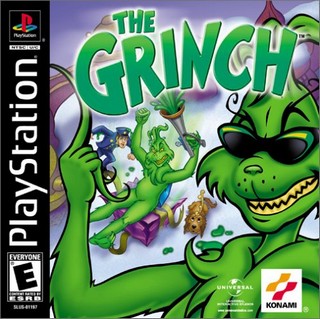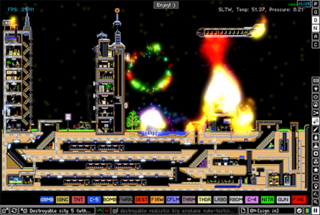
A music video game, also commonly known as a music game, is a video game where the gameplay is meaningfully and often almost entirely oriented around the player's interactions with a musical score or individual songs. Music video games may take a variety of forms and are often grouped with puzzle games due to their common use of "rhythmically generated puzzles".

RollerCoaster Tycoon 3 is a 2004 construction and management simulation video game. It is the third installment in the RollerCoaster Tycoon series, and was developed by Frontier Developments and published by Atari Interactive. RollerCoaster Tycoon 3 places players in charge of managing amusement parks; rides can be built or demolished, terrain and scenery can be adjusted, and prices can be controlled to keep visitors or "peeps" happy.

CryEngine is a game engine designed by the German game developer Crytek. It has been used in all of their titles with the initial version being used in Far Cry, and continues to be updated to support new consoles and hardware for their games. It has also been used for many third-party games under Crytek's licensing scheme, including Sniper: Ghost Warrior 2 and SNOW. Warhorse Studios uses a modified version of the engine for their medieval RPG Kingdom Come: Deliverance. Ubisoft maintains an in-house, heavily modified version of CryEngine from the original Far Cry called the Dunia Engine, which is used in their later iterations of the Far Cry series.

A Grand Theft Auto clone belongs to a subgenre of open world action-adventure video games, characterized by their likeness to the Grand Theft Auto series in either gameplay, or overall design. In these types of open world games, players may find and use a variety of vehicles and weapons while roaming freely in an open world setting. The objective of Grand Theft Auto clones is to complete a sequence of core missions involving driving and shooting, but often side-missions and minigames are added to improve replay value. The storylines of games in this subgenre typically have strong themes of crime, violence and other controversial elements such as drugs and sexually explicit content.

The Grinch is a 2000 platform video game loosely based on the film How the Grinch Stole Christmas. Developed by Artificial Mind & Movement and published by Konami, the game was released in North America one week prior to the film's theatrical release—November 10, 2000. George Lowe does uncredited work as the narrator of the game. The Game Boy Color version was released that same month, which was ported for a release in Japan on November 22, 2000.
Non-games are a class of software on the border between video games and toys. The term "non-game game" was coined by late Nintendo president Satoru Iwata, who describes it as "a form of entertainment that really doesn't have a winner, or even a real conclusion". Will Wright had previously used the term "software toy" for the same purpose. The main difference between non-games and traditional video games is the lack of structured goals, objectives, and challenges. This allows the player a greater degree of self-expression through freeform play, since they can set up their own goals to achieve. Some genres that have been considered non-games include language-learning software, digital tabletop games, puzzle games, simulation games, and art games.

A sandbox game is a video game with a gameplay element that provides players a great degree of creativity to interact with, usually without any predetermined goal, or alternatively with a goal that the players set for themselves. Such games may lack any objective, and are sometimes referred to as non-games or software toys. More often, sandbox games result from these creative elements being incorporated into other genres and allowing for emergent gameplay. Sandbox games are often associated with an open world concept which gives the players freedom of movement and progression in the game's world. The term "sandbox" derives from the nature of a sandbox that lets people create nearly anything they want within it.
A space flight simulation is a genre of flight simulator video games that lets players experience space flight to varying degrees of realism. Common mechanics include space exploration, space trade and space combat.

Tropico 3 is a video game developed by Haemimont Games and published by Kalypso Media. Like the previous games in the series, Tropico 3 is a construction and management simulation as well as a political simulation game, with emphasis on city building. As a thematic sequel to Tropico, the game attempts to return to the roots of the series, which puts the player into the shoes of "El Presidente" – a ruler governing over an island banana republic.
Universe Sandbox is a series of interactive space sandbox gravity simulator educational software video games. Using Universe Sandbox, users can see the effects of gravity on objects in the universe and run scale simulations of the Solar System, various galaxies or other simulations, while at the same time interacting and maintaining control over gravity, time, and other objects in the universe, such as moons, planets, asteroids, comets, and black holes. The original Universe Sandbox was only available for Windows-based PCs, but an updated version was released for Windows, macOS, and Linux in 2015.

The Powder Toy is a falling-sand game originally created by Stanislaw K. Skowronek. It is now developed and maintained by LBPHacker, Simon, jacob1 and other contributors on GitHub. The Powder Toy is free and open-source software licensed under the GNU General Public License version 3.0. A total of 185 different in-game materials, each with custom behavior and interactions, are available in the game.

Le Mans 24 Hours is a video game released for the PlayStation, Game Boy Color, Dreamcast, PlayStation 2, and Microsoft Windows. The Dreamcast version was ported and published by Sega in Japan on 15 March 2001, while the PlayStation 2 version was ported and published by the same company on 13 June. Based on the famous 24 hours of Le Mans race in France, the player is invited to race the entire 24-hour endurance course or take part in a simpler arcade mode. The game also featured tracks such as Bugatti Circuit, Brno Circuit, Road Atlanta, Suzuka Circuit, Donington Park and Circuit de Catalunya, as well as a weather and night system.
Luminous Engine, originally called Luminous Studio, is a multi-platform game engine developed and used internally by Square Enix and later on by Luminous Productions. The engine was developed for and targeted at eighth-generation hardware and DirectX 11-compatible platforms, such as Xbox One, the PlayStation 4, and versions of Microsoft Windows. It was conceived during the development of Final Fantasy XIII-2 to be compatible with next generation consoles that their existing platform, Crystal Tools, could not handle.

Spike Chunsoft Co., Ltd. is a Japanese video game development and localization company specializing in role-playing video games, visual novels and adventure games. The company was founded in 1984 as Chunsoft Co., Ltd. and merged with Spike in 2012. It is owned by Dwango.

Noita is a platform roguelike game developed by Nolla Games. Players control a witch that can collect and cast spells in order to defeat enemies named after Finnish mythological creatures. The main game leads the player down a cave ending in a boss fight, although the game contains much more secret and supplementary content. It was released in early access for Microsoft Windows on 24 September 2019. Noita left early access as the 1.0 version was released on 15 October 2020.











